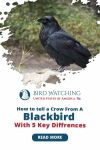
What’s This Post About?
During your birding spree, you might come across a plethora of birds flying around. Wearing your binoculars to get a close view, and your field guide in hand, you try to identify the numerous species hopping on the ground, perched onto the trees, and singing their tunes on the electrical poles.
You may spot a bird with an overall black plumage, but what might bemuse you is the thought, is it a crow or a Blackbird? How do you tell the difference between the two resembling species?
Besides having an all-rounded black color, there are several distinctive features. Crows have a distinct shaped beak and tail relative to the blackbirds. Apart from their physical traits, notable differences include their mating patterns, the structure of nests, social habits, and even their vocalizations.

Read through this comprehensive guide to explore the dynamic differences between the two birds so next time you see a bird perched on the branch of the tree, you can rightly tell what it is.
A Blackbird or A Crow? Learn How to Tell Them Apart!
Even though a crow is a black-colored bird, it is a distinct species, not related to the Blackbird in any way. If you pay close attention, you’ll notice the subtle, underlying differences between the two birds.
Whether you’re standing in your backyard to enjoy the stunning species of birds stopping by, or taking a stroll in the middle of the town square, or traveling on the outskirts near the cultivated fields, you are likely to spot a flock of highly prevalent black colored birds flying around you.
Unless we observe a few cues, we cannot be sure whether the bird right in front is a crow or one of the many Blackbirds.

If your inquisitiveness to study the birds thoroughly causes you to delve into the in-depth behavior and lifestyle of the two birds, you’ll observe vast differences.
Some of the notable ones include:
- The shape of the Beak and Tail
- Size of the Birds
- Different Settling habitats
- Distinctive calls and songs sung by the birds
- Breeding and Nesting Patterns
- Movements and foraging styles
- Social Behavior
Read through some of the distinct differences in detail.
1. Physical Appearance
From a distance, both the birds appear to be almost the same but making astute observations, you’ll note the differences in the physical characteristics of the birds.
2. Tail
Take a close look at the tail of the birds - one of the best indicators to tell the birds apart. During the flight, the crow’s tail displays a fan-shaped appearance which can be attributed to the fairly similar size of its tail feathers.
On the other hand, if you look carefully, you’ll notice that the Blackbirds have fairly long tails that taper to a point.
3. Beak
The beak of a crow is profoundly different from that of a Blackbird. Unlike the tail which depicts its true shape only when the bird is in flight or is perched, the beak’s shape stays relatively constant.
The crow’s beak, almost black, may appear to be deep purple in sunlight.
Having a relatively large beak, almost 2 inches long, its all-purpose, strong bill allows the crows to easily feed on seeds, fruits, insects, and other animals comprising its diet. Slightly arching towards the tip with a gentle slope, the bill is otherwise straight.

The bill of Blackbirds is moderately sized, not necessarily black, but each species sports a different color. Aiding the bird to feed on bugs, insects, and berries, the thin and pointed bill makes for accurate identification of the bird.
The common Blackbird of the US flashes a bright yellow-orange bill so you can tell it’s not the raspy crow in the fields.

4. Size
With a little bit of adeptness, you may be able to identify the bird by looking at its overall shape and size.
While the crows are 16 to 20 inches in size, easily visible perched in dense tree branches, the many species of Blackbirds vary in size, typically ranging around 9 to 11 inches.
5. Distinctive Physical Traits
The crow is an all-rounder black-colored bird, from its eyes to its bills down to the feet.
In Blackbirds, however, you are likely to find a distinctive slight tinge of color, sometimes on the wing bar, eyes, or even the beak. The table below helps understand the blackbirds better.
| Type | Distinct Features |
|---|---|
| Common Blackbird | Yellow ring around its eyes |
| Brewer’s Blackbird | Unique yellow-colored eye and sporting a deep purplish-blue iridescent head |
| Yellow-headed Blackbird | Vibrant yello head and chest |
| Red-winged Blackbird | Small red patch of feathers on the shoulder and a yellow wing bar |
6. Location - Birding Spot
The area where you spot the bird is of paramount importance in determining which bird just caught your eye. Diligently look for environmental indications around you that make it simpler to narrow down the list of possible species that you caught a glimpse of.
Let’s consider you’re birding in an area unaccustomed to Blackbirds. You can be sure the bird that just flapped its wings was a crow.
Knowing which bird is prevalent in the area and its preferred habitat makes the job much simpler. At this point, your field guide particularly comes in handy. To be your useful assistant in the birding spree, we recommend choosing an easily portable version with clear illustrations.
Here is one which we would recommend – the National Geographic Field Guide to the Birds of North America.
National Geographic Field Guide to the Birds of North America
With more than 2.75 million copies in print, this perennial bestseller is the most frequently updated of all North American bird field guides.
The American crow is one of the most widespread birds in the country, found in all sorts of habitats from the remote forests to farmlands and woodlands as well as colonizing the parks and residential communities.
Did you know?
One of the favorite foods of crows is corn seeds - so next time you see a bevy of black-colored birds foraging in the cornfields, you will know right away which bird it is.
Taking a look at the Blackbird, it has several species, that are spread over a vast region in Europe and America. Inhabiting and breeding major parts of the country, it’s not a rare sight to spot the bird during your birding trip.
Blackbirds prefer to inhabit the remote woodlands, preferring deciduous forests with dense undergrowth. Nonetheless, they are frequent visitors to backyards and reside in parks, gardens, and hedgerows near the populated areas.
Fun Fact!
Being frequent visitors to areas with human settlements, both the blackbirds and the crows can adapt well to humans around them.
Having a strong inclination towards open areas and subtly forested trees, both the birds can be found in such regions, perching on tree branches as they coo their songs, throwing you in a state of bewilderment to identify the bird.
7. Vocalizations
Your eyes just don’t play a part in bird recognition. Experienced birders understand the significance of being able to recognize the vocalizations of the myriad of species of birds around.
In fact, in the case of some minuscule birds, hearing their songs from the dense shrubs or highly elevated branches notifies the birders of their presence.
Listening closely to the bird song of the two species, you can easily differentiate between them. The most frequent call of a crow is its distinct loud and rapid ‘caw caw’ uttered in an abrasively raspy and coarse tone.

Familiar to almost everyone, this call is in no way close to what you might call a melodic warble.
In comparison to crows, Blackbirds call out a relatively pleasing, melodious tone, usually during the breeding season. Often you might hear the bird give out few other calls such as the aggressive pook pook pook alarm or the chink chink calls in attempts to deter other birds from entering its territory.
Unlike their general appearance, the calls of the two birds are in no way similar, so if you hear the birds singing first, you know the answer!
Fun Fact!
Crows have a vast vocabulary – as many as 250 different sounds!
8. Breeding
If you’re a bird fanatic who might want to explore the bird more comprehensively, observe its breeding patterns. Both the species have ostensibly different breeding styles.
Crows are known to be family-oriented birds - not leaving their mate until their death. These monogamous, cooperative species will mate for life, producing around 15 offspring.
Unlike other birds, the crows do not kick out their young ones from the nest, but rather the nestlings do not leave their nests to breed for four to five years. Even after they create their nests, the offspring visit their parents often, continuing their familial ties.
Generally, the Blackbird is also socially monogamous, usually mating for life. However, there are some species like the Red-winged Blackbird that do not mate for life and the male might mate with other female Blackbirds around.
These promiscuous species of the Blackbird will mate with several other partners during the breeding season.
If you get a chance to closely observe the nests of the polygamous species of Blackbirds, know that the male Blackbird might not be the only father of all the eggs, while the male would have its babies in the nest of other females as well!

9. Nesting
The way the crows build their nests also distinguishes them from Blackbirds.
Due to their sociability, Blackbirds prefer to build nests in colonial areas as this has a higher chance of protection and security of their eggs and nestlings.
Once they select a suitable nest site in the creeper, bush, or on the highly elevated branches of the tree, the female takes the lead role in the formation of the nests.
Using leaves, grass, twigs, and other vegetation, the blackbirds bind the nests together with mud, creating a dainty nest shaped into a delicately cushioned cup for their eggs.
However, if you happen to closely examine the nests of crows, you’ll note the sturdy and bulky structure of the nests, quite distinct from that of Blackbirds, primarily made with sticks and twigs.
You can find the large structures in an array of deciduous trees from conifers and oak trees to dense bushes and sometimes on the ground and windows of buildings as well.
Warning!
Some species of Blackbirds, particularly the Red-winged Blackbird can become aggressive and swoop down on humans to protect their nests. Beware when stepping close to the nests!
10. Social Behavior
Crows are one of the most gregarious and the noisiest birds around, often found in large congregations called murders too busy bustling around in parks, farm fields, and open streets or perched at rooftops.
The intelligent bird is known to be the problem solver amongst them all, using clever strategies such as throwing the nuts viciously on the ground to break them.
Fun Fact!
Have you ever noticed the crows using tools to figure out problems that might seem inaccessible for them? It's quite common for them to use small sticks to poke into something or bend wires to create bent hooks. That's very rare of birds! Crows are the only non-primates to make use of such equipment.
Without any hesitance, the crow calls its huge murder to ward off attacks from any potential predator. Usually very genial with other birds around, the crow exhibits an astonishingly aggressive behavior when found around owls or raptors.
With others of its family, the crows are very tender-hearted. If they see a dead crow around, all the crows gather in solidarity, expressing their mournfulness in silence and then dispersing quietly.
This behavior is rare among the birds, but the crows cohesively conduct a funeral of their fellow birds.

The various species of the Blackbirds are also often seen in flocks and loose groups, though their groups are not as large as the crows.
Not only do they visit the bird feeders frequently, but the outgoing bird loves to forage on the ground as it hops and runs at a fast pace, feeding seeds, berries, bugs, and insects.
Blackbirds spend much of their time searching for food. For this reason, you’ll not only find the bird in the agricultural fields and city parks but also in the marshlands and wetlands due to the lush food choices that the bird can feed on, even capturing the aquatic invertebrates that it can spot on the surface of the water.

Keep Reading!
Telling a crow from the Blackbird at the first glance can undoubtedly be tricky. But now that we know what elements to consider to identify that bird perched on the rooftops, you can easily recognize which bird it is.
From having visual indicators such as distinctive tail ends and visibly varying beaks to the environmental cues such as habitats in which you see them, the birds have eminently different characteristics.
To explore tips to attract the blackbirds and crows into your backyard, and create a rousing environment, read our blog on what fruits to feed backyard birds.
The 10 Proven Fruits to Feed and Attract Backyard Birds
Are you a bird lover but struggle with what fruits to feed backyard birds? Well keep on reading and you learn our tips to attract them.

By David A. Swanson
Bird Watching USA
My name is David and I'm the the founder of Bird Watching USA! I started Bird Watching with My father-in-law many years ago, and I've become an addict to watching these beautiful creatures. I've learnt so much over about bird watching over the years that I want to share with the world everything I know about them!

David A. Swanson
Bird Watching USA
My name is David and I'm the the founder of Bird Watching USA! I started Bird Watching with My father-in-law many years ago, and I've become an addict to watching these beautiful creatures. I've learnt so much over about bird watching over the years that I want to share with the world everything I know about them!




![What?! Do Geese Really have Teeth?! [24 Awesome Pictures] Thumbnail](/assets/resized/img/posts/do-geese-have-teeth-100x150.jpg)


![What?! Do Geese Really have Teeth?! [24 Awesome Pictures] Thumbnail](/assets/resized/img/posts/do-geese-have-teeth_thumbnail-100x56.jpg)


